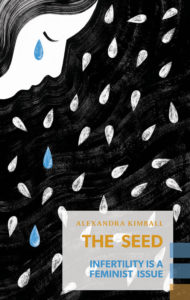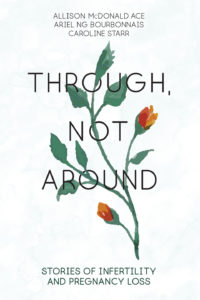April 24, 2019
The Myriad Nature of Maternal Grief

Everything I know about infertility, I’ve come to understand through the analogy of abortion, which is not the opposite of infertility—though some people might have you imagine so. For your information, adoption and miscarriage are not the opposite of abortion either, as the many people who’ve had both abortions and miscarriages can definitely attest, and those women who’ve experienced adoption too. (And pay attention here, to the challenge of going beyond a single story in women’s experiences—a theme. To an insistence in our rhetoric on either/or, and maybe neither if you’re lucky, but never both.)
While I’ve not experienced infertility, I have had an abortion, which means that I’ve spent a lot of the last seventeen years thinking about reproductive choice (which delivered me the rest of my life, after all, so I spend a lot of time saying thank you). And in this thinking it occurred to me that such notions of choice must necessarily include women who want to be pregnant but aren’t, women I feel solidarity with because both experiences (wanting to be pregnant when you’re not and not wanting to be pregnant when you are) have feelings of grief and such abject despair at their core. And similarly do abortion and infertility attract the wrath of patriarchal forces, because there is nothing our society likes less than a woman who exercises agency over her destiny, who refuses to be a passive vessel.
(An additional commonality I’d never considered until reading Alexandra Kimball’s book is that abhorring abortion and dismissing the trauma of infertility both require diminishing the physical labour required to be pregnant and also that to become pregnant through reproductive technology. Abortion and infertility treatments are both considered, by those who don’t know any better, as a matter of simple “convenience,” equivocating women’s labour with, just say, a breakfast sandwich from Starbucks.)
And so Alexandra Kimball’s The Seed: Infertility is a Feminist Issue was always going to one of the books I’ve most been looking forward to this spring. (The first time I read Kimball’s work was a 2015 essay on miscarriage, which was also about her abortion, and I am always interested when abortion/miscarriage/infertility are part of the same conversation; and note: they were also all part of the conversation in the anthology I edited in 2014, The M Word: Conversations About Motherhood).
But I will admit that while I was looking forward to The Seed, its thesis (that feminism has failed infertile women) made me uncomfortable—and certainly it’s even supposed to, and it’s provocative. But what I mean is that I didn’t start reading the book completely on board, and I felt its central premise would possibly be a bit overstated. (This is kind of like when you’re white, and a racialized person tells you about their experience of racism, and you suppose they’re just being a bit sensitive.)
But it was by about page 50 and her analysis of The Handmaid’s Tale and infertility in pop culture (after the chapter on infertile women as monstrous in myth and folklore, beginning with a Babylonian epic from 18th century BC, right up to witchcraft trials just a couple of hundred years ago) that Kimball had me convinced that she was not just being sensitive. After discussing pop culture infertility in films like Fatal Attraction and The Hand That Rocks the Cradle (infertile women literally destroying the everywoman’s life) she turns to The Handmaid’s Tale, and concludes that while it is “unequivocally, a feminist text…in its world, female barrenness is not only…threatening…disgusting… it is outright oppressive, a necessary engine for patriarchy itself.”
Kimball’s analysis from here is about the tension within feminism toward motherhood in general: “an idea of motherhood as conscription into patriarchy remained central to feminist theory and action.” And how feminism’s emphasis on CONTROL in terms of reproduction left little space for those women whose experiences were beyond their control—she quotes Linda Layne on the monumental Our Bodies, Ourselves, which included miscarriage and infertility in a separate (and unillustrated) chapter at end of the book.
And who exactly gets to be in control of their reproductive lives was quite specific from the start in feminist circles—racism and classism have always played a role in this. So that even now, the experiences of racialized, queer and poor people are alienated from conversations about fertility, which itself is alienated from conversations within feminism anyway. Kimball shows numerous examples of people in general and feminists in particular being much more concerned with and disturbed by ideas about people resolving their infertility than the problem of infertility itself.
And why is it so easy for our rhetoric to remain so unconcerned about the experience of the infertile woman? “They ignore the grief,” writes Kimball, who notes that she has never felt as objectified as she did when she was infertile. “It’s difficult to see [an infertile woman] as anything other than a curiosity of capitalism, akin to people who undergo cosmetic surgery.” She writes about “the existential clusterfuck of this trauma,” how the tragedy of infertility is that resolution always seems just close enough at hand to be worth pursuing. “It’s less of a biological impulse than a narrative one, a need for coherence and sense.”
And here, Kimball begins to see the possibilities of sisterhood, of solidarity, for she finds it with a friend who a trans woman whose own experiences have been very different but who understands the extent of Kimball’s grief in a way that few other people do. (Kimball also points out that Trans-Exclusionary-Radical-Feminists find women pursuing fertility as challenging to their politics as they do trans women.) She further identifies with the the artworks of Catherine Opie and Frieda Kahlo, how they portray bodily labour and grief. “I looked at Opie’s portrait series and Kahlo’s miscarriage works frequently when I was struggling, not so much because they mirrored my own experience or made me feel less lonely, but because I was heartened by what I felt was the complexity of their stories… They demonstrate the myriad nature of maternal grief.”

That myriad nature is explored in the essay anthology Through, Not Around: Stories of Infertility and Pregnancy Loss, edited by Allison McDonald Ace, Ariel Ng Bourbonnais and Caroline Starr, a work that challenges “the single narrative” that Kimball complicates and writes against in her cultural analysis. In Through, Not Around, the political is made personal again with 22 stories of infertility, miscarriage and stillbirth, mostly by women, but with a handful by men. Each writer is telling a story that is far from uncommon, but which was until recently taboo (and even remains so in many cultures). As Kimball writes, society is made uncomfortable by evidence of the effort and labour of motherhood, would prefer it to remain hidden so we can continue to believe it is natural, essential.
My only critique of this collection is the lack of contributor bios, because it would be interesting to see what a range of backgrounds these writers are coming from. (Although I try to think of reasons why contributor bios might be avoided here, and I can think of some answers. What happens when we let the stories speak for themselves?) My sense is that these writers come from a fairly broad spectrum of experience (although, for reasons Kimball has illuminated, racialized, queer and poor women are in the minority here, as they are in conversations about fertility in general) and that most of them are not professional writers. (The anthology was born of the online community The 16 Percent.) And so I was impressed by how excellently written most of these essays were, how they made stories out of experiences that defy the conventions of narrative at every turn. (There is a reason you rarely read a novel where someone ends up having five miscarriages.)
The grief that Kimball writes about is evident in these essays, which are stories of strength and resilience under sometimes unrelenting pressure. The point indeed is getting through, which requires action instead of passiveness. But also questions of when to try a different path forward, when to stop, and all the surprising diversions that happen along the way. Women’s lives, we read in these essays, are fraught and brutal and hard and knit with tragedy, but are also unfailingly interesting.
There are so many ways to be a woman, and to become a mother, or to be infertile, even. I’m grateful to both these books for complicating the narrative in the very best way.





